Abstract
The antioxidant capacity of the glutathione redox cycle and the concentrations of selenium in serum, red blood cells or whole blood, and polymorphonuclear leucocytes was evaluated in nine patients with severe rheumatoid arthritis (RA) and eight healthy controls receiving daily supplementation with 250 micrograms selenomethionine for six months. Serum and whole blood concentrations of selenium and the activity of the selenium dependent enzyme glutathione peroxidase (GSH-Px) were low in the serum, red blood cells, and polymorphonuclear leucocytes of patients with RA before selenium supplementation. During supplementation serum and whole blood concentrations of selenium and the activity of GSH-Px in serum and red blood cells of patients with RA and serum GSH-Px in controls increased. Selenium and GSH-Px in polymorphonuclear leucocytes were unaffected in patients with RA in contrast with the controls where both were augmented. Glutathione reductase activity in the red blood cells and polymorphonuclear leucocytes of patients with RA was low but increased during selenium supplementation. Whole blood concentrations of glutathione were slightly lower in patients with RA than controls and no difference in the content in polymorphonuclear leucocytes was found between the groups. The activity in red blood cells of glucose-6-phosphate dehydrogenase was high in patients with RA, indicating sufficient function of the hexose monophosphate pathway. The reduced antioxidant activity of the glutathione redox cycle in patients with severe RA was mainly due to the low availability of selenium. This was further supported by the response to selenium supplementation in serum and red blood cells. In the polymorphonuclear leucocytes, however, no biochemical effects of selenium supplementation were seen. This lack of antioxidative response could play a pathogenetic part in inflammation in patients with RA.
Full text
PDF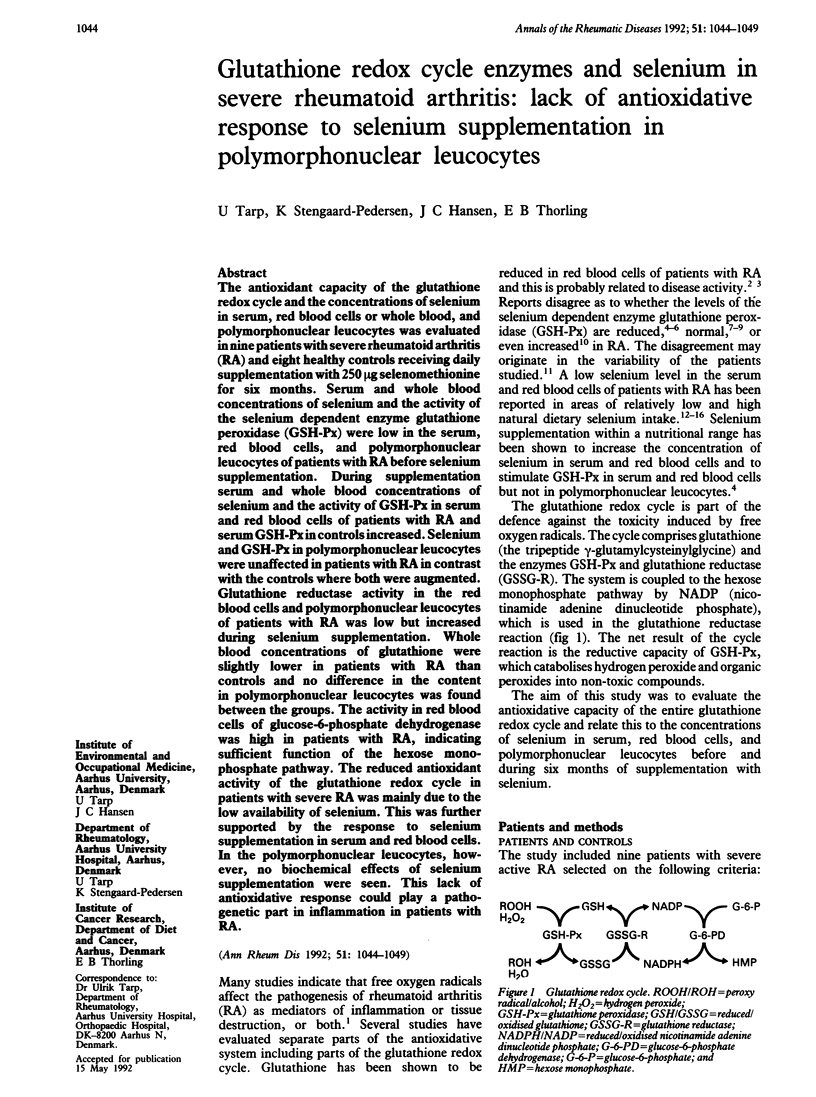
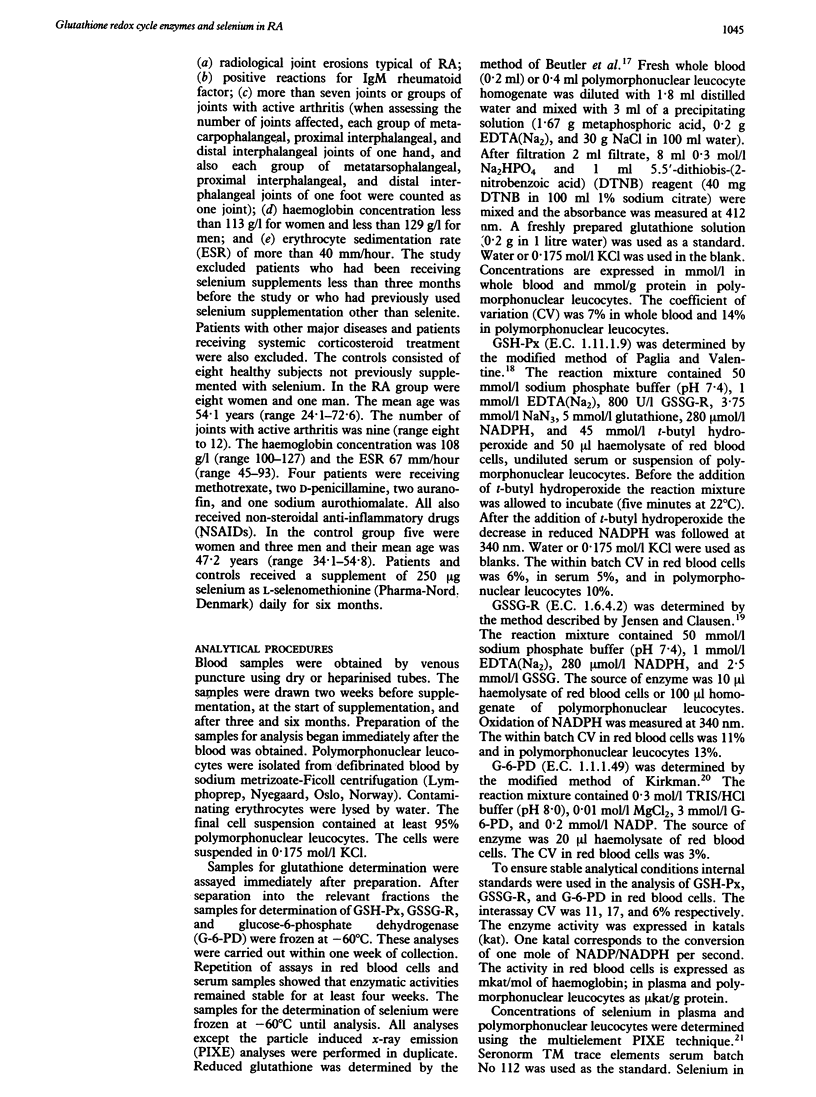

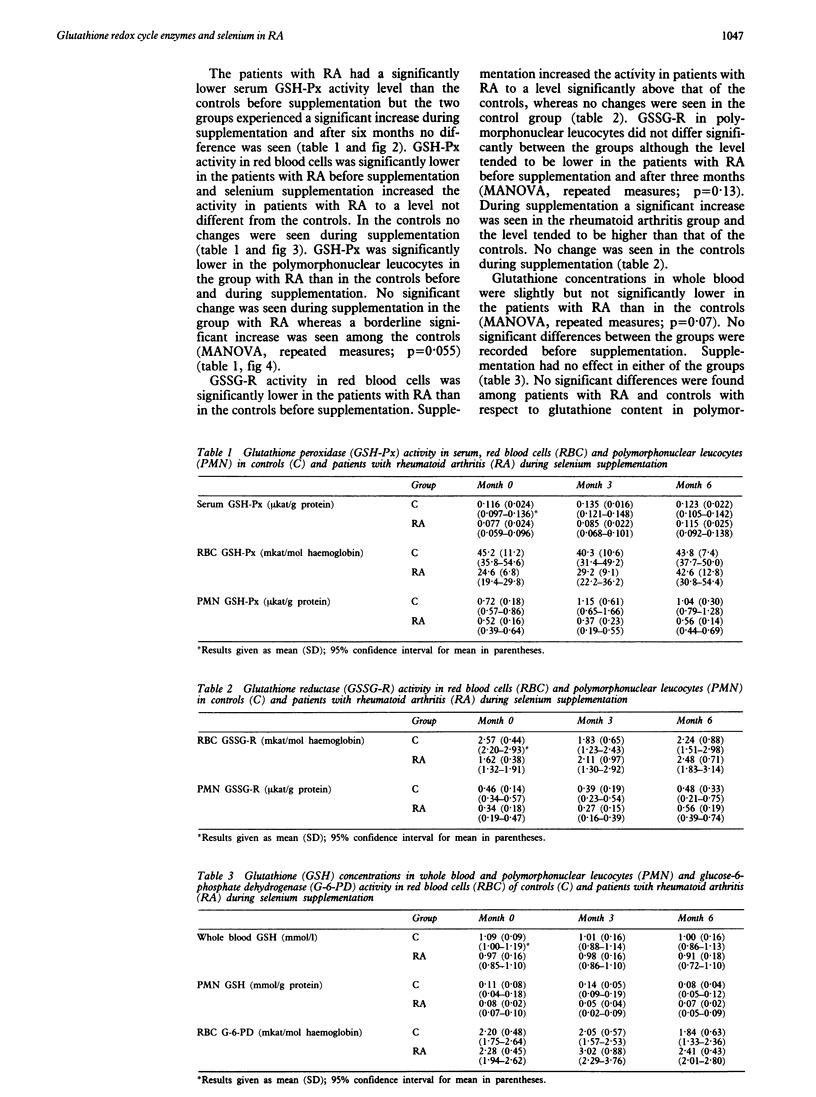
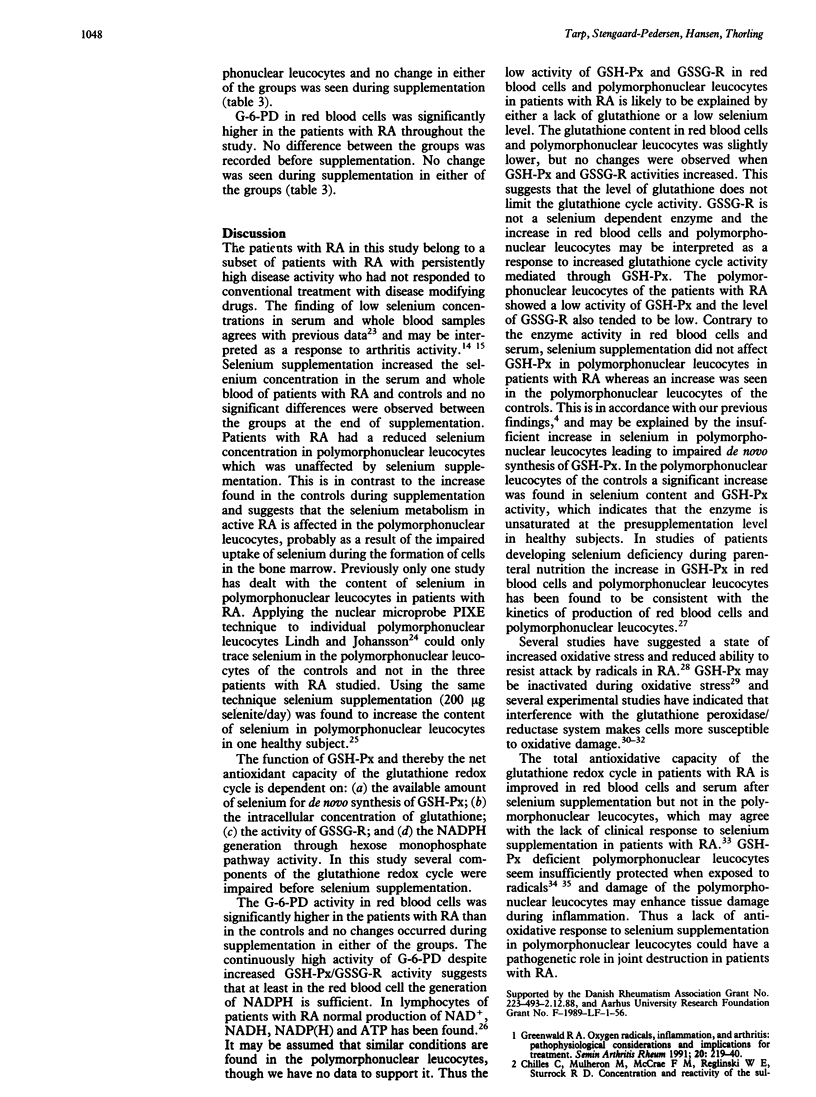
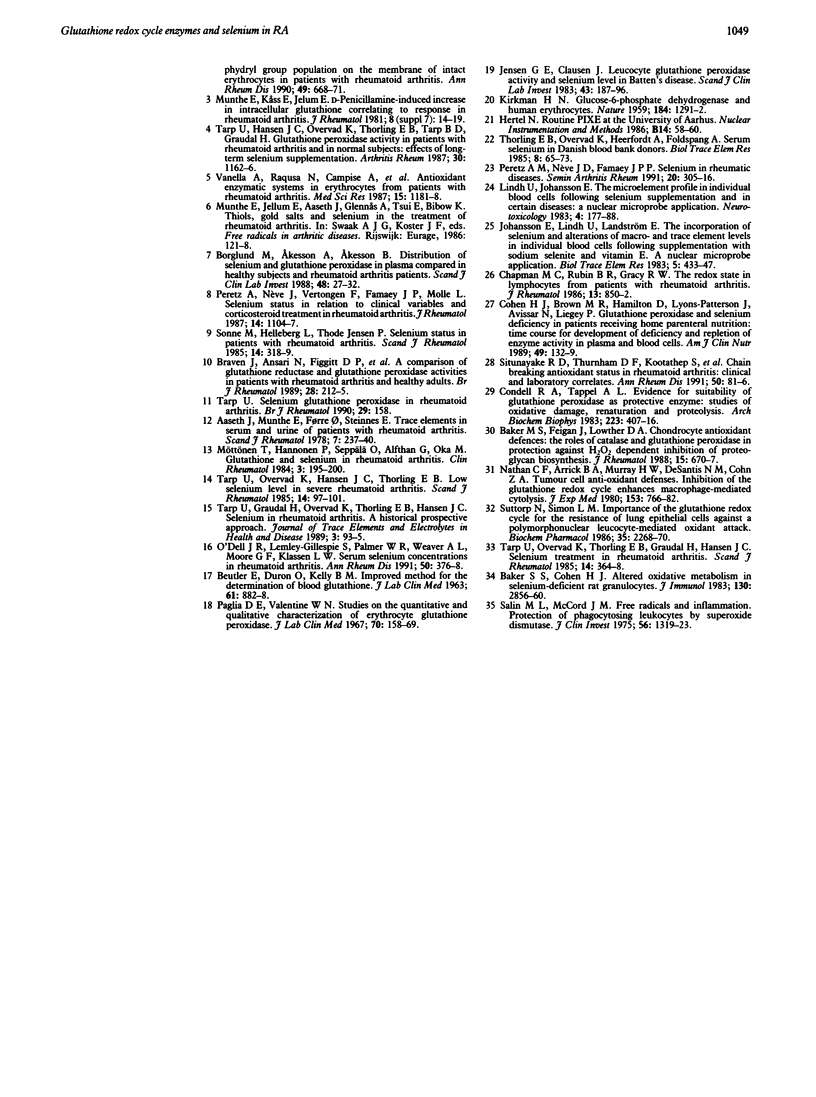
Selected References
These references are in PubMed. This may not be the complete list of references from this article.
- Aaseth J., Munthe E., Førre O., Steinnes E. Trace elements in serum and urine of patients with rheumatoid arthritis. Scand J Rheumatol. 1978;7(4):237–240. doi: 10.3109/03009747809095662. [DOI] [PubMed] [Google Scholar]
- Baker M. S., Feigan J., Lowther D. A. Chondrocyte antioxidant defences: the roles of catalase and glutathione peroxidase in protection against H2O2 dependent inhibition of proteoglycan biosynthesis. J Rheumatol. 1988 Apr;15(4):670–677. [PubMed] [Google Scholar]
- Baker S. S., Cohen H. J. Altered oxidative metabolism in selenium-deficient rat granulocytes. J Immunol. 1983 Jun;130(6):2856–2860. [PubMed] [Google Scholar]
- Borglund M., Akesson A., Akesson B. Distribution of selenium and glutathione peroxidase in plasma compared in healthy subjects and rheumatoid arthritis patients. Scand J Clin Lab Invest. 1988 Feb;48(1):27–32. doi: 10.3109/00365518809085390. [DOI] [PubMed] [Google Scholar]
- Braven J., Ansari N., Figgitt D. P., Fisher A., Luders C., Hickling P., Whittaker M. A comparison of glutathione reductase and glutathione peroxidase activities in patients with rheumatoid arthritis and healthy adults. Br J Rheumatol. 1989 Jun;28(3):212–215. doi: 10.1093/rheumatology/28.3.212. [DOI] [PubMed] [Google Scholar]
- Chilles C., Mulheron M., McCrae F. M., Reglinksi J., Smith W. E., Brzeski M., Sturrock R. D. Concentration and reactivity of the sulphydryl group population on the membrane of intact erythrocytes in patients with rheumatoid arthritis. Ann Rheum Dis. 1990 Sep;49(9):668–671. doi: 10.1136/ard.49.9.668. [DOI] [PMC free article] [PubMed] [Google Scholar]
- Cohen H. J., Brown M. R., Hamilton D., Lyons-Patterson J., Avissar N., Liegey P. Glutathione peroxidase and selenium deficiency in patients receiving home parenteral nutrition: time course for development of deficiency and repletion of enzyme activity in plasma and blood cells. Am J Clin Nutr. 1989 Jan;49(1):132–139. doi: 10.1093/ajcn/49.1.132. [DOI] [PubMed] [Google Scholar]
- Condell R. A., Tappel A. L. Evidence for suitability of glutathione peroxidase as a protective enzyme: studies of oxidative damage, renaturation, and proteolysis. Arch Biochem Biophys. 1983 Jun;223(2):407–416. doi: 10.1016/0003-9861(83)90604-5. [DOI] [PubMed] [Google Scholar]
- Greenwald R. A. Oxygen radicals, inflammation, and arthritis: pathophysiological considerations and implications for treatment. Semin Arthritis Rheum. 1991 Feb;20(4):219–240. doi: 10.1016/0049-0172(91)90018-u. [DOI] [PubMed] [Google Scholar]
- Jensen G. E., Clausen J. Leucocyte glutathione peroxidase activity and selenium level in Batten's disease. Scand J Clin Lab Invest. 1983 May;43(3):187–196. [PubMed] [Google Scholar]
- KIRKMAN H. N. Charasteristics of glucose-6-phosphate dehydrogenase from normal and primaquine-sensitive erythrocytes. Nature. 1959 Oct 24;184:1291–1292. doi: 10.1038/1841291a0. [DOI] [PubMed] [Google Scholar]
- Lindh U., Johansson E. The microelement profile in individual blood cells following selenium supplementation and in certain diseases: a nuclear microprobe application. Neurotoxicology. 1983 Fall;4(3):177–188. [PubMed] [Google Scholar]
- Munthe E., Kåss E., Jellum E. D-penicillamine-induced increase in intracellular glutathione correlating to clinical response in rheumatoid arthritis. J Rheumatol Suppl. 1981 Jan-Feb;7:14–19. [PubMed] [Google Scholar]
- Möttönen T., Hannonen P., Seppälä O., Alfthan G., Oka M. Glutathione and selenium in rheumatoid arthritis. Clin Rheumatol. 1984 Jun;3(2):195–200. doi: 10.1007/BF02030754. [DOI] [PubMed] [Google Scholar]
- Nathan C. F., Arrick B. A., Murray H. W., DeSantis N. M., Cohn Z. A. Tumor cell anti-oxidant defenses. Inhibition of the glutathione redox cycle enhances macrophage-mediated cytolysis. J Exp Med. 1981 Apr 1;153(4):766–782. doi: 10.1084/jem.153.4.766. [DOI] [PMC free article] [PubMed] [Google Scholar]
- O'Dell J. R., Lemley-Gillespie S., Palmer W. R., Weaver A. L., Moore G. F., Klassen L. W. Serum selenium concentrations in rheumatoid arthritis. Ann Rheum Dis. 1991 Jun;50(6):376–378. doi: 10.1136/ard.50.6.376. [DOI] [PMC free article] [PubMed] [Google Scholar]
- Paglia D. E., Valentine W. N. Studies on the quantitative and qualitative characterization of erythrocyte glutathione peroxidase. J Lab Clin Med. 1967 Jul;70(1):158–169. [PubMed] [Google Scholar]
- Peretz A. M., Nève J. D., Famaey J. P. Selenium in rheumatic diseases. Semin Arthritis Rheum. 1991 Apr;20(5):305–316. doi: 10.1016/0049-0172(91)90031-t. [DOI] [PubMed] [Google Scholar]
- Peretz A., Neve J., Vertongen F., Famaey J. P., Molle L. Selenium status in relation to clinical variables and corticosteroid treatment in rheumatoid arthritis. J Rheumatol. 1987 Dec;14(6):1104–1107. [PubMed] [Google Scholar]
- Salin M. L., McCord J. M. Free radicals and inflammation. Protection of phagocytosine leukocytes by superoxide dismutase. J Clin Invest. 1975 Nov;56(5):1319–1323. doi: 10.1172/JCI108208. [DOI] [PMC free article] [PubMed] [Google Scholar]
- Situnayake R. D., Thurnham D. I., Kootathep S., Chirico S., Lunec J., Davis M., McConkey B. Chain breaking antioxidant status in rheumatoid arthritis: clinical and laboratory correlates. Ann Rheum Dis. 1991 Feb;50(2):81–86. doi: 10.1136/ard.50.2.81. [DOI] [PMC free article] [PubMed] [Google Scholar]
- Sonne M., Helleberg L., Jensen P. T. Selenium status in patients with rheumatoid arthritis. Scand J Rheumatol. 1985;14(3):318–319. doi: 10.3109/03009748509100414. [DOI] [PubMed] [Google Scholar]
- Suttorp N., Simon L. M. Importance of the glutathione redox cycle for the resistance of lung epithelial cells against a polymorphonuclear leukocyte-mediated oxidant attack. Biochem Pharmacol. 1986 Jul 1;35(13):2268–2270. doi: 10.1016/0006-2952(86)90605-2. [DOI] [PubMed] [Google Scholar]
- Tarp U., Graudal H., Overvad K., Thorling E. B., Hansen J. C. Selenium in rheumatoid arthritis. A historical prospective approach. J Trace Elem Electrolytes Health Dis. 1989 Jun;3(2):93–95. [PubMed] [Google Scholar]
- Tarp U., Hansen J. C., Overvad K., Thorling E. B., Tarp B. D., Graudal H. Glutathione peroxidase activity in patients with rheumatoid arthritis and in normal subjects: effects of long-term selenium supplementation. Arthritis Rheum. 1987 Oct;30(10):1162–1166. doi: 10.1002/art.1780301012. [DOI] [PubMed] [Google Scholar]
- Tarp U., Overvad K., Hansen J. C., Thorling E. B. Low selenium level in severe rheumatoid arthritis. Scand J Rheumatol. 1985;14(2):97–101. doi: 10.3109/03009748509165490. [DOI] [PubMed] [Google Scholar]
- Tarp U., Overvad K., Thorling E. B., Graudal H., Hansen J. C. Selenium treatment in rheumatoid arthritis. Scand J Rheumatol. 1985;14(4):364–368. doi: 10.3109/03009748509102039. [DOI] [PubMed] [Google Scholar]
- Tarp U. Selenium glutathione peroxidase in rheumatoid arthritis. Br J Rheumatol. 1990 Apr;29(2):158–158. doi: 10.1093/rheumatology/29.2.158-a. [DOI] [PubMed] [Google Scholar]


